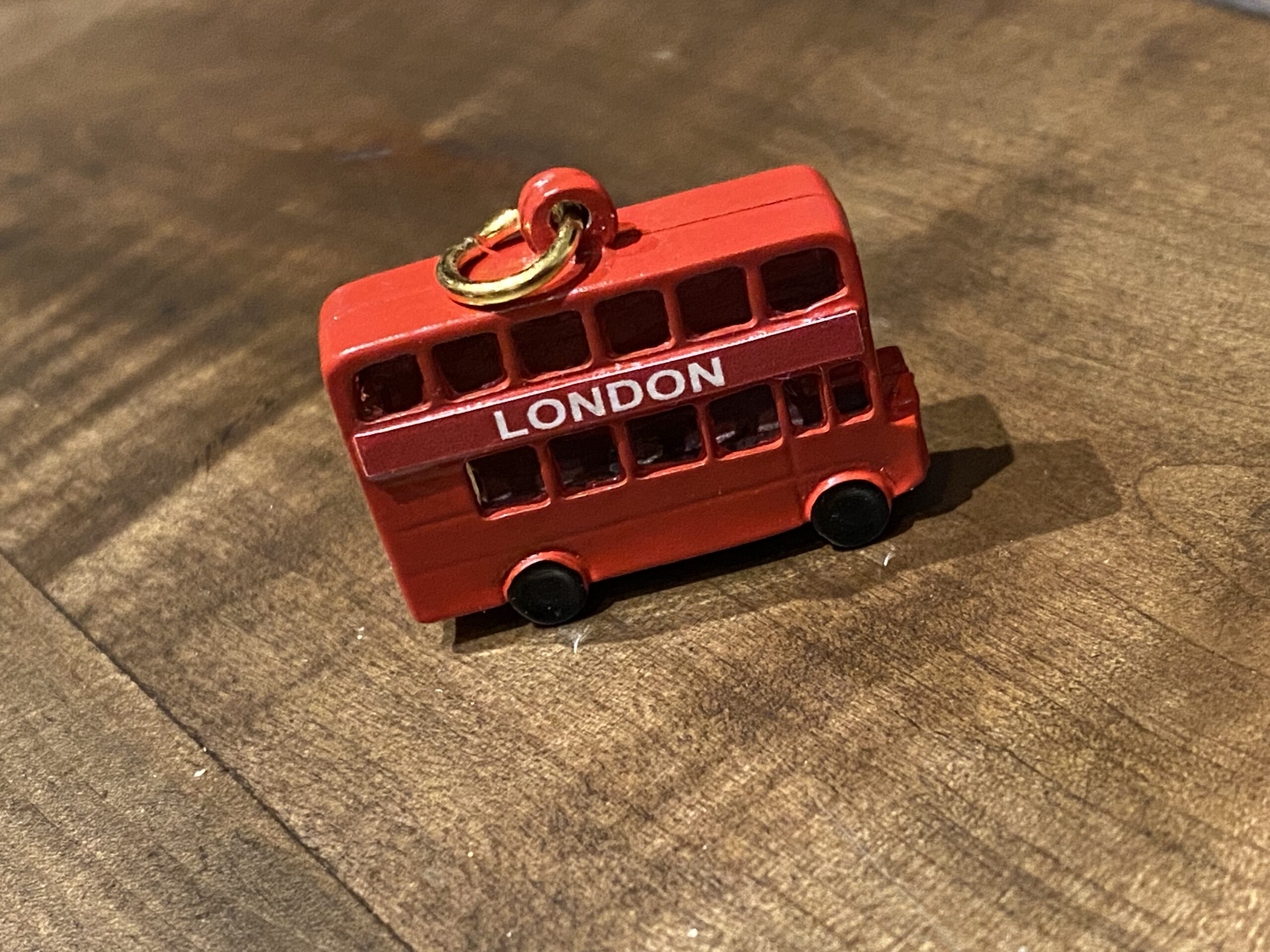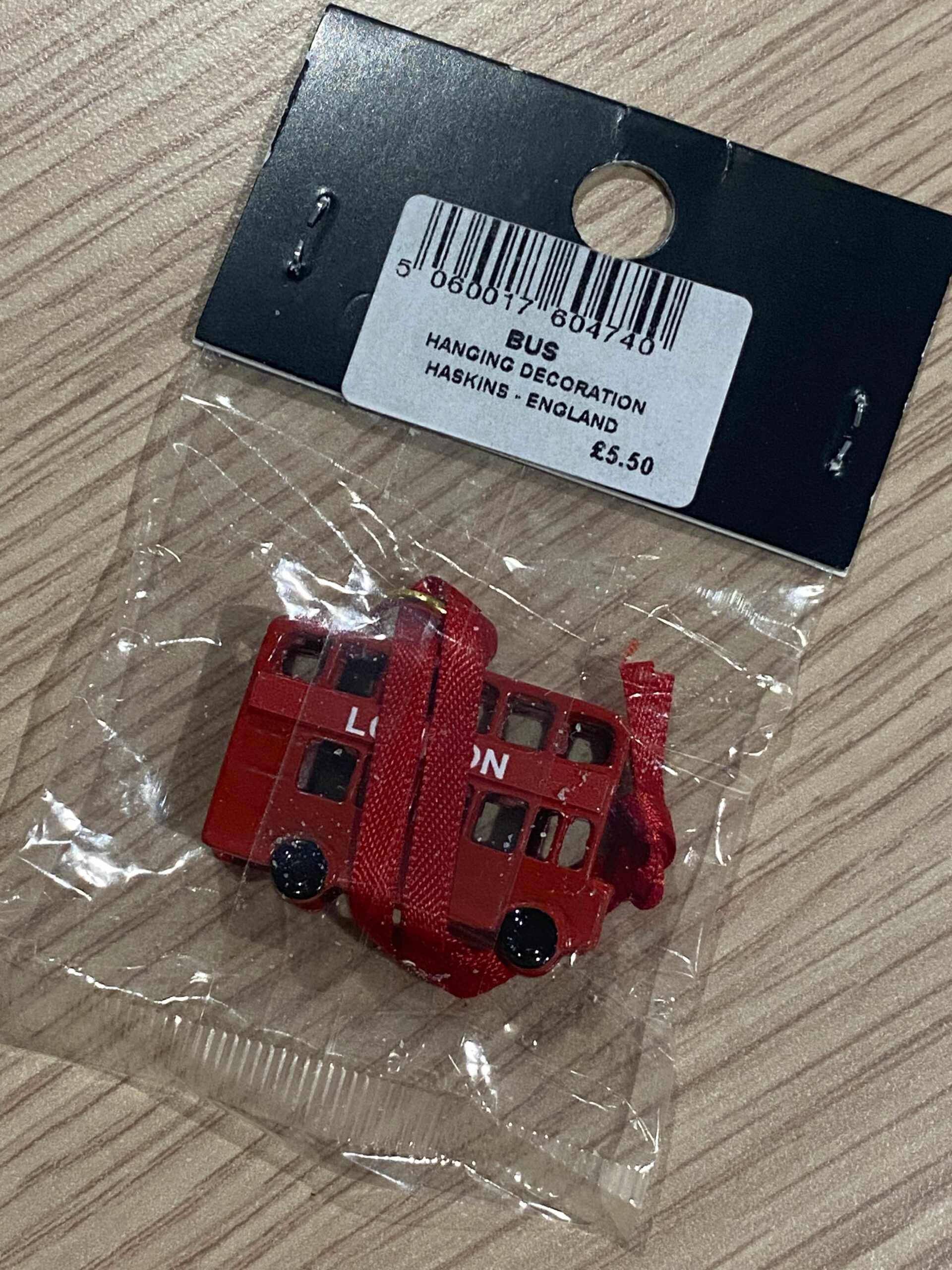Incredibly toxic and dangerous souvenir purchased at the Tower of London gift shop (November 2022)
Published: December 18, 2022 — Sunday
Well … I guess I can really pick ’em! I have a special talent (actually, body of knowledge and experience) that enables me to easily pick out the most toxic souvenir in the shop! I purchased this at the Tower of London Gift Shop last month — because it was very tiny… and very heavy! It came with a red ribbon — and per the display, it was ostensibly being sold as a Christmas ornament (the exact same bus, same size, colors, and materials, was also being sold in another section of the store as a keychain fob).
This bus is tiny (see photo with coin above) — and could so easily wind up in a child’s mouth.
In purchasing this cheap little souvenir (it cost £5.50, about $6,00), I chose it specifically because it was suspiciously heavy for something so small. My instincts told me this could likely be made of LEAD (or —though far less likely — I desperately hoped that maybe, if someone was paying attention and, um, not trying to poison tourists, perhaps it was just made of solid Zinc?).
But I was actually shocked and surprised when my testing revealed that this tiny object was likely made of nearly 100% PURE CADMIUM (over 900,000 ppm Cadmium)! (For those who don’t know anything about Cadmium, it is a well established carcinogen that causes cancer even with human exposures to very low levels.) But wait… is the Cadmium in the paint? Or is it in the substrate? How do you know? Read more about that at this link.
It’s hard to say with 100% certainty (since I did not do destructive testing of the object), but it might in fact be a solid Cadmium metal figurine, painted with Lead-contaminated paint (though it is possible that the Lead levels detected [2,716 ppm] are actually also coming from within the Cadmium metal substrate). Regardless of where the Lead (or Cadmium) may be in this object (the paint or the substrate), we are talking about a very small charm (just a little bigger than one might expect for Jewelry) that tests positive for over 900,000 ppm Cadmium using XRF technology; for context, in the State of California, children’s Jewelry (or ornaments that may be used/ worn by kids — which I think a keychain may fall under) is considered illegal and unsafe with XRF-detectable Cadmium levels that exceed 300 ppm (three hundred parts per million). (To read more about Cadmium limits in consumer goods, click here.)
Needless to say, I intend to follow up with the Tower of London about this issue. The people who work there take pride that the killing (beheading, poisoning, and such) with which the Tower is infamously associated is only it’s macabre past — not it’s future … and I want to help them keep it that way!(Update: The Tower responded within 24 hours! Here’s the link with our full email communication thread.)
XRF test results for the bus ornament pictured
30-second test
- Lead (Pb): 2,716 +/- 414 ppm
- Cadmium (Cd): 929,700 +/- 12,000 ppm
- Tin (Sn): non-detect
- Mercury (Hg): non-detect
- Selenium (Se): non-detect
- Barium (Ba): non-detect
- Chromium (Cr): non-detect
- Antimony (Sb): non-detect
- Copper (Cu): 1,102 +/- 507 ppm
- Zinc (Zn): 56,000 +/- 2,000 ppm
- Niobium (Nb): 201 +/- 91 ppm
- Titanium (Ti): non-detect
- Zirconium (Zr): non-detect
- Indium (In): non-detect
- Iron (Fe): non-detect
- Bismuth (Bi): non-detect
- No other metals were detected in consumer goods mode.
For those new to this website:
Tamara Rubin is a multiple-federal-award-winning independent advocate for childhood Lead poisoning prevention and consumer goods safety, and a documentary filmmaker. She is also a mother of Lead-poisoned children (two of her sons were acutely Lead-poisoned in 2005). Since 2009, Tamara has been using XRF technology (a scientific method used by the U.S. Consumer Product Safety Commission) to test consumer goods for toxicants (specifically heavy metals — including Lead, Cadmium, Mercury, Antimony, and Arsenic). All test results reported on this website are science-based, accurate, and replicable. Items are tested multiple times to confirm the test results for each component tested. Tamara’s work was featured in Consumer Reports Magazine in February of 2023 (March 2023 print edition).

Never Miss an Important Article Again!
Join our Email List

















Wow! What a shocker! It’s still horrifying, even after all you have shown us over the years!
For size reference, could you please place a pen pr some other object beside the bus in one of the photos?
Many thanks,
Kath.
Hi – you are psychic. Just updated with a nickel.
T
Thank you for testing and sharing. It is really helpful for our campaign to have real examples of non-compliant items sold in the UK.
I have almost the exact same London bus I bought as a souvenir in 2014 from a tourist shop in Liverpool. It’s a fridge magnet, and my youngest child loved to look and play with it! I’m shocked how high the reading is on this item. I’d say mine would read the same as it looks very similar
Very interesting article. I’ve just read your “What do you use to test for Lead?”; “Can I do this myself at home?”; “How much does it cost?” article on how testing should be done.
Does your equipment provide accurate readings for paint and also does it penetrate all the way through painted surfaces into the metal to give accurate readings of both substrates?
I also note from your article: “To learn more about XRF testing used for testing house paint (which is a different conversation entirely – both a different type of instrumentation AND a different unit of measure [Milligrams Per Centimeter Squared / mg/cm2] than what is reported on this blog – click here).”
Looking at your results, you tested in “Consumer goods mode”. This looks like a painted item…. therefore you should have tested it in paint mode with the measurement in ” Milligrams per centimeter squared (mg/cm2)” first to analyse the paint element.
After first testing the paint, presumably you should have then removed all the paint and retested it in consumer goods mode for the Parts Per Million (ppm) test to give accurate results of the metal composition?
I am concerned that this article undermines your good work and may be misleading based on your own guidance on how items should be tested. It would helpful for us as consumers to have accurate results based on the actual compositions of each element of this product.
The XRF instrument (testing in consumer goods mode) typically reads through the paint (and even through most enamels) to the substrate below. I rarely do destructive testing of objects – as it is difficult to do safely (and surface readings of objects is what is expected for consumer goods evaluation for safety.) I have a follow up piece on this that I will share shortly too.
Also the milligram per cm squared readings are for house paint, not for paint on consumer goods – those need to be tested in ppm for compliance with regulatory standards for consumer goods.
Hi Tamara,
I am following this article with interest. Your response to my original questions has been bugging me somewhat over the last couple of days, particularly as you’ve been saying you can’t be 100% certain and are accusing the Tower of poisoning tourists (I’m from the Uk and am passionate about consumer safety).
FROM TAMARA: point of clarification. I am 100% certain about the levels of toxicants found, that is not a question at all. The only lack of certainty is about whether or not all of it is in the substrate or some of it is in the paint – which doesn’t matter in the end because regardless of the location of the toxicants found they are still at levels that are highly toxic and unsafe for kids.
I’ve again looked at your methodology and also at the specification sheet for the Niton XL3t that you use. The modes on the gun are as follows (taken directly from the manufacturers spec sheet https://www.thermofisher.com/document-connect/document-connect.html?url=https://assets.thermofisher.com/TFS-Assets%2FCAD%2FSpecification-Sheets%2FNiton-XL3t-Spec-Sheet.pdf):
Mode (Varies by Application):
Alloy Modes: Metal Alloy, Electronics Alloy, Precious Metals
Bulk Modes: Mining, Soil
Plastic Modes: RoHS Plastics, Toy & Consumer Goods Plastics, TestAll™, Painted Products
Other Modes: Lead Paint, Thin Sample
Custom Modes: Upon request (based on application feasibility)
The spec sheet shows plastic dinosaurs being scanned. No where can I see a painted metal product mode or a metal consumer goods mode ??? Is it possible that you’ve used the Plastic Mode : Toy and Consumer Goods Plastics? If you have used this mode surely this means that your results cannot be accurate?
POINT OF CLARIFICATION FROM TAMARA: I only post test results on my website that are 100% accurate, science based and replicable. The test results are certain. The only uncertainty is the question of substrate vs. paint since I don’t do destructive testing. I addressed this a bit in my follow up email to the Tower of London Gift Shop folks (link here.)
I’ve also watched some labs using XRF testing on YouTube and they have all, under lab conditions, separated each substrate and tested them individually for accurate results. If you haven’t done this and are also using a plastic detection mode on a complete metal painted item how can your results be accurate?
Also how are you able to hold and test such a small item that has holes going through it without getting contaminated results from the table or whatever you rest the item on whilst testing? Or do you follow strict lab protocols?
POINT OF CLARIFICATION FROM TAMARA: I always test objects against a surfaces that I first test and confirm to be free of metals. I normally use a plain wood (unstained / no paint) confirmed-metals-free cutting board that I purchased expressly for this purpose. I have several other surface I also occasionally use for testing (depending on where / when I am doing the testing) but they are all confirmed to free of metals.
I look forward to hearing your thoughts explanation of the testing method.
Keep up the good work.
Elizabeth
I am going to put my response embedded in your comment.
Elizabeth,
If you are interested in preventing lead exposure and poisoning in the UK you might like to endorse the work of the Lead Exposure and Poisoning (LEAPP) Alliance – https://leappalliance.org.uk/join/
Is it possible that the cadmium and lead are in the substrate and the paint is cadmium and leadfree?
Well done for following this up with the Tower of London!!! No-one wants a deadly souvenir!!!